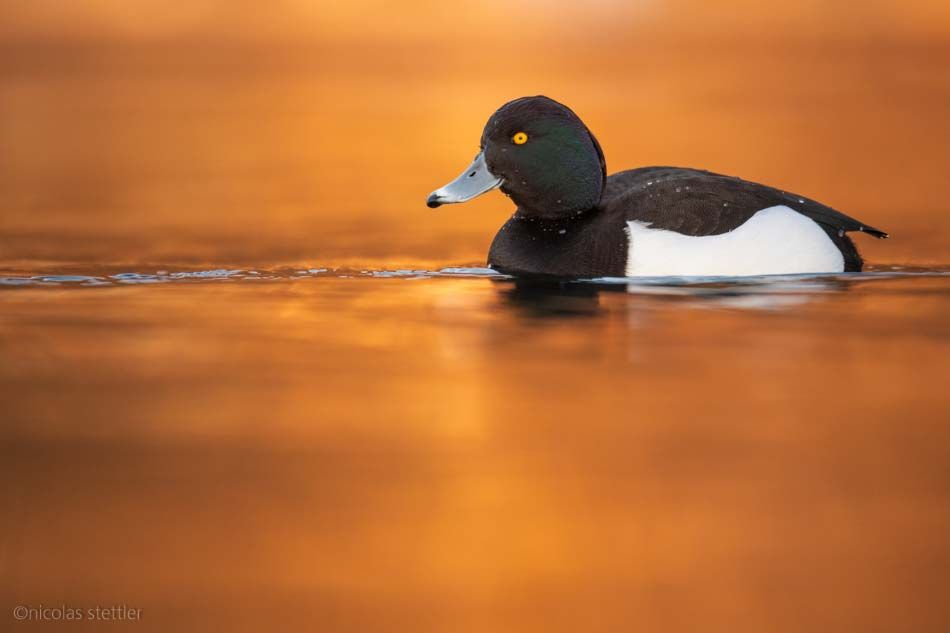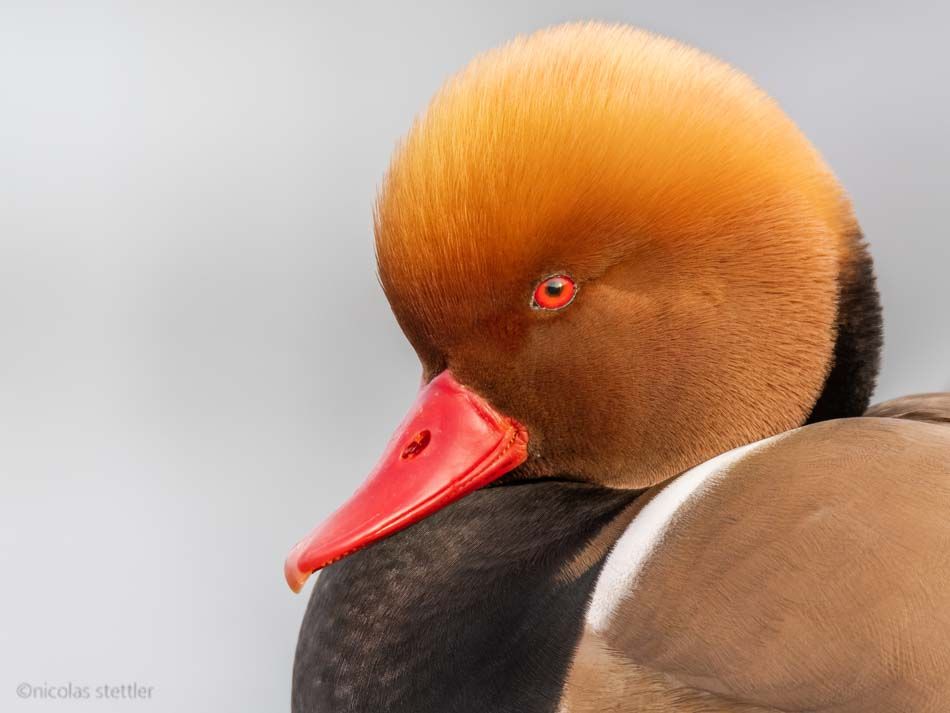How to get close to ducks
It often requires a lot of patience and luck to photograph water birds and especially ducks. To take portraits and close-ups you need even more luck. Though there are some things you can do to get closer to ducks. In this article you will find out how I can get so close to these shy animals.
Location
As I mentioned in one of the previous articles of this blog series, the location plays an important role in photographing water birds. To get very close to water birds and especially ducks, harbours and park ponds are much better suited than nature reserves. In harbours and park ponds, ducks have become somewhat used to the presence of humans. Sometimes the ducks may even be interested in you. Apart from the frequent Mallards, Coots and Mute swans, there are also Common merganser and Tufted ducks that are interested in the bread of pedestrians.

I had never seen this Tufted duck eating bread. Nevertheless, it was not very shy, and it was always hanging out near the shore, where it was diving for mussels. On this particular morning, the sun had just risen and illuminated the opposite shore. The golden shore was reflected in the water and the background in the picture became a nice uniform orange.
Season
In autumn, most duck species are quite shy. Most of them have just flown from their breeding grounds to Switzerland. The ducks probably didn’t meet any humans in their breeding areas. Having arrived in their wintering grounds, the ducks are quite timid for the time being. But the ducks learn quickly and realize that we are probably not so dangerous after all.
Towards the end of the winter, the winter visitors have more or less got used to the humans. Therefore, taking pictures becomes easier towards the end of the winter. Especially for portraits the time from February to the end of March is much better than autumn. I myself have taken almost every portrait of a duck species in late winter and early spring.
Individuals vs. Flocks

Depending on the species of bird or duck, they behave differently when they are in groups or by themselves. Most of the time, water birds in groups are much more difficult to photograph. It only takes one twitchy duck and the whole group is nervous.

Individual birds are often a bit more tolerant. Especially resting individual ducks are often the easiest to photograph. But sometimes you get in the somewhat ironic situation when you are only a few meters away from the duck and it continues to sleep undisturbed. Although sleeping ducks open their eyes again and again, they do not take the beak out of their plumage so quickly.
Camouflage
Anyone who has ever photographed water birds with camouflage knows that somehow the ducks always know that there is a human under the camouflage. Depending on the camouflage the ducks stay close enough to you for a ‘landscapy’ image. But it is extremely rare that they swim up to you, so you can take close-ups of them. For that reason, camouflage is in most cases not very useful, especially when you want to take portraits. I would even go so far as to say that camouflage is a hindrance for portraits.
It is much better to be accepted by a water bird as a human being as to hiding under a camo netting. If you are accepted by the ducks as a harmless person, first of all you get much closer to the ducks and secondly you can adapt your position according to light and pose of the duck. This is very important for taking portraits as small adjustments of your camera position can make a huge difference. If I can move the camera a little to the left and right, I can choose the background. But I can also adjust the perspective a little bit. If I were under a normal hide, I would not have this ability.
How to get close to ducks

In bird photography the aim should always be that the birds come towards you by themselves. Because ducks are very shy, this is rarely the case. Although there are some tricks for this, especially for portraits you almost always have to get closer to the ducks by yourself. Because a duck will never come at the distance for portraits by itself. Approaching ducks is quite difficult and should be done with extreme caution and respect. Ducks are very shy and quite skittish animals.
The welfare of the birds is ALWAYS a priority and you should avoid frightening ducks. It is no problem when a flock of ducks have to swim a little bit away from you. As long as the ducks don’t have to fly away it is not that big of a deal. To prevent the ducks from swimming away there are of course some tricks.
Use wind and current
Ducks in water never stay in the same place. While the route of active ducks is difficult to predict, sleeping ducks can drift for minutes without them changing direction. Use wind and current and try to position yourself so that the ducks slowly drift towards you.
Some species of ducks, such as the common merganser, are also easy to predict when foraging. They often simply swim along the shore. Lay down to the ground in front of the ducks and they will swim right past you. Depending on the species, they will make a slight curve around you though.
The 'mobile phone search'
If the ducks are on land, the wind and current will not help you. To get closer to the birds, you have to get closer to them yourself. There is a trick to do this. I myself use this trick mostly with ducks, which are still quite far away from me. Instead of running directly towards them, which would be possible for another 20-30m without chasing the ducks away, I walk all over the place and 'search' my mobile phone.
Seemingly without goal I slowly approach the ducks. They have noticed me for a long time, but they do not consider me a danger. The most difficult part is to lie down to reach eye level. The ducks immediately notice that I’m not just looking for my phone after all. To keep the ducks calm, it takes some experience and luck. But if you manage to get to eye level, you already have a very good chance of being able to photograph the ducks at close range.

If I want to get even closer to the duck, I approach it very carefully. Centimetre by centimetre I slowly approach the ducks. In between I make longer breaks so that the ducks get used to me again. Often, I need more than half an hour for these last few metres. But the patience usually pays off. Once you are at a good distance, you can photograph the ducks while they are sleeping or taking care of their feathers.
Dive and Dash
Another method can only be used with diving ducks and other water birds. Here you use the time when the duck is underwater to move a few meters forward. This method is also called 'Dive and Dash'. I heard about this method for the first time in the podcast of Scott Keys. The best way to do this is, is to measure the time of a few dives before. After a few seconds you should lie down on the ground and wait until the duck comes up and dives again. In the best case you will get very close to the duck.
You might also find interesting:
The 11 most common Ducks of Switzerland
Many ducks overwinter here in Switzerland. But how can you identify them. In this article, I'll talk about the most common ducks in Switzerland. You'll learn where they live and how you can identify them.
Bird Photography - Create impressive Images
Photographing birds can be very difficult. In this article you will learn how to create impressive and unique pictures of birds. I explain what you should pay attention to when taking pictures and where you can find birds that you can easily photograph. Learn from my tips and tricks, which I myself have learned in the last years while photographing.

